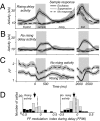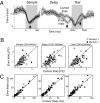Trial-to-trial variability of the prefrontal neurons reveals the nature of their engagement in a motion discrimination task
- PMID: 21098286
- PMCID: PMC3003075
- DOI: 10.1073/pnas.1009956107
Trial-to-trial variability of the prefrontal neurons reveals the nature of their engagement in a motion discrimination task
Abstract
During motion discrimination tasks, many prefrontal cortex (PFC) neurons are strongly modulated by the behavioral context, suggesting their involvement in sensory discriminations. Recent studies suggest that trial-to-trial variability of spiking activity characteristic of cortical neurons could be a source of information about the state of neurons and their participation in behavioral tasks. We tested this hypothesis by examining the variability of putative pyramidal PFC neurons, a likely source of top-down influences. The variability of these neurons was calculated as a ratio of spike count variance to its mean (fano factor, FF), while monkeys compared the directions of two moving stimuli, sample and test, separated by a delay. We found that the FF tracked consecutive components of the task, dropping rapidly with the onset of stimuli being discriminated and declining more slowly before each salient event of the trial: The sample, the test, and the response. These time-dependent signals were less consistent in direction selective neurons and were largely absent during passive fixation. Furthermore, neurons with test responses that reflected the remembered sample decreased their FF well before the test, revealing the predictive nature of response variability, an effect present only during the active task. The FF was also sensitive to behavioral performance, exhibiting different temporal dynamics on error trials. These changes did not depend on firing rates and were often the only metric correlated with task demands. Our results demonstrate that trial-to-trial variability provides a sensitive measure of the engagement of putative pyramidal PFC neurons in circuits subserving discrimination tasks.
Conflict of interest statement
The authors declare no conflict of interest.
Figures







Similar articles
-
Common rules guide comparisons of speed and direction of motion in the dorsolateral prefrontal cortex.J Neurosci. 2013 Jan 16;33(3):972-86. doi: 10.1523/JNEUROSCI.4075-12.2013. J Neurosci. 2013. PMID: 23325236 Free PMC article.
-
Directional signals in the prefrontal cortex and in area MT during a working memory for visual motion task.J Neurosci. 2006 Nov 8;26(45):11726-42. doi: 10.1523/JNEUROSCI.3420-06.2006. J Neurosci. 2006. PMID: 17093094 Free PMC article.
-
Memory-guided sensory comparisons in the prefrontal cortex: contribution of putative pyramidal cells and interneurons.J Neurosci. 2012 Feb 22;32(8):2747-61. doi: 10.1523/JNEUROSCI.5135-11.2012. J Neurosci. 2012. PMID: 22357858 Free PMC article.
-
Flexibility of sensory representations in prefrontal cortex depends on cell type.Neuron. 2009 Dec 10;64(5):730-43. doi: 10.1016/j.neuron.2009.11.018. Neuron. 2009. PMID: 20005828 Free PMC article.
-
Linking Neuronal Direction Selectivity to Perceptual Decisions About Visual Motion.Annu Rev Vis Sci. 2020 Sep 15;6:335-362. doi: 10.1146/annurev-vision-121219-081816. Annu Rev Vis Sci. 2020. PMID: 32936737 Review.
Cited by
-
Exact distinction of excitatory and inhibitory neurons in neural networks: a study with GFP-GAD67 neurons optically and electrophysiologically recognized on multielectrode arrays.Front Neural Circuits. 2012 Sep 6;6:63. doi: 10.3389/fncir.2012.00063. eCollection 2012. Front Neural Circuits. 2012. PMID: 22973197 Free PMC article.
-
Perceptual Learning beyond Perception: Mnemonic Representation in Early Visual Cortex and Intraparietal Sulcus.J Neurosci. 2021 May 19;41(20):4476-4486. doi: 10.1523/JNEUROSCI.2780-20.2021. Epub 2021 Apr 2. J Neurosci. 2021. PMID: 33811151 Free PMC article.
-
Convergent approaches toward the study of multisensory perception.Front Syst Neurosci. 2013 Nov 8;7:81. doi: 10.3389/fnsys.2013.00081. eCollection 2013. Front Syst Neurosci. 2013. PMID: 24265607 Free PMC article. Review.
-
Flexible models for spike count data with both over- and under- dispersion.J Comput Neurosci. 2016 Aug;41(1):29-43. doi: 10.1007/s10827-016-0603-y. Epub 2016 Mar 23. J Comput Neurosci. 2016. PMID: 27008191
-
Role of Odor Novelty on Olfactory Issues in Autism Spectrum Disorder.Genes Brain Behav. 2024 Dec;23(6):e70008. doi: 10.1111/gbb.70008. Genes Brain Behav. 2024. PMID: 39723617 Free PMC article. Review.
References
-
- Miller EK. The prefrontal cortex and cognitive control. Nat Rev Neurosci. 2000;1:59–65. - PubMed
-
- Miller EK, Cohen JD. An integrative theory of prefrontal cortex function. Annu Rev Neurosci. 2001;24:167–202. - PubMed
-
- Freedman DJ, Riesenhuber M, Poggio T, Miller EK. Categorical representation of visual stimuli in the primate prefrontal cortex. Science. 2001;291:312–316. - PubMed
Publication types
MeSH terms
Grants and funding
LinkOut - more resources
Full Text Sources
Miscellaneous

